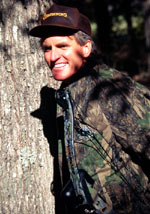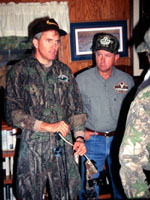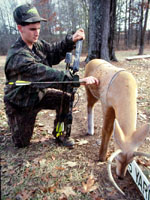
|
Features
|
|
|
|
Books
|
|
|
|
Fun & Games
|
|
|
|
Contact Us
|
|
|
John's Journal... Entry 160, Day 1
THE DISTANCE TO SUCCESS
Judging Distance
 EDITOR'S
NOTE: Many hunters prepare for hunting season by shooting 3D archery.
Several critical elements will help you win 3-D archery tournaments, including
your bow's ability to perform flawlessly, skill at holding the bow steady
through the shot, control over your nerves and emotions in the face of
high-pressure competition and the ability to judge your distance from
the target. 3-D tournament archers often find judging distance the one
chink in their armor. Misreading the distance even by 1/2 to 1 yard can
determine whether you hit the 12 ring or the 8 ring. Most of the nation's
best 3-D archers utilize more than one technique to judge distance to
a target. Here are some of their secrets.
EDITOR'S
NOTE: Many hunters prepare for hunting season by shooting 3D archery.
Several critical elements will help you win 3-D archery tournaments, including
your bow's ability to perform flawlessly, skill at holding the bow steady
through the shot, control over your nerves and emotions in the face of
high-pressure competition and the ability to judge your distance from
the target. 3-D tournament archers often find judging distance the one
chink in their armor. Misreading the distance even by 1/2 to 1 yard can
determine whether you hit the 12 ring or the 8 ring. Most of the nation's
best 3-D archers utilize more than one technique to judge distance to
a target. Here are some of their secrets.
The Association of Professional Archers has ranked Randy Ulmer of Cave Creek, Arizona No. 1 several times. He also has won Cabela's Shooter of the Year award, the IBO National Triple Crown Championship and the title of "3-D & Target Archer" Male Shooter Of The Year a couple of times. An avid hunter, Ulmer also has taken a Boone and Crockett elk with his bow that scored 375 6/8-points.
 "Most
of my yardage estimation is based on my perception of how far I am from
a McKenzie 3-D target," Ulmer said. "In the past, I've imagined a 20-yard-long
pole that I lay on the ground to know how far 20 yards is. By simply turning
the pole over mentally, I can estimate where 40 yards is. If the target
is at more than 40 yards, I'll judge the distance in 1-yard increments.
At work, at home and everywhere I go, I'm always pacing off 20 yards.
"Most
of my yardage estimation is based on my perception of how far I am from
a McKenzie 3-D target," Ulmer said. "In the past, I've imagined a 20-yard-long
pole that I lay on the ground to know how far 20 yards is. By simply turning
the pole over mentally, I can estimate where 40 yards is. If the target
is at more than 40 yards, I'll judge the distance in 1-yard increments.
At work, at home and everywhere I go, I'm always pacing off 20 yards.
"When I was in high school, I was a pitcher," Ulmer said. "Because the distance from the pitcher's mound to the catcher's glove was 20 yards, I've always had a real good mental picture of what 20 yards looks like. However, after having shot McKenzie targets, probably at least 100 times each for the last seven years, I feel very comfortable when I look at a target. I'm assured that I know the range, whether that deer is at 22 or 45 yards. I'm much like a basketball player who shoots hoops. If you take a basketball player out to a court that doesn't have any marks or lines on it, he still can shoot the ball accurately because he's shot from so many positions on the court for so long. He knows how far the goal is from where he's shooting, and he'll shoot accurately. When you've shot 3-D archery enough, you get that same sense of knowing the distance you are from the target that the basketball player gets of knowing the distance he is from the goal. Today, I judge distance by knowing I can depend on my visual calculations based on the size of the targets to shoot accurately. When I walk up to the stake, I look at the target, estimate the distance and immediately set my sight. I'll next use my imaginary pole to judge the yardage in 20-yard increments. Then I'll use what I call my half-way judging. I'll look at the ground, pick out a spot and say that spot is half-way between me and the target. Then I'll mentally lay my 20-yard pole on the ground and determine where that spot hits on my mental 20-yard pole. Judging the yardage by using several different methods means I'll very rarely shoot a 5. If I judge the yardage using these three methods and each method gives me different distances, then I'll back away from the target and start all over again. I'll know something is wrong with my system.
 When
I step to the line to shoot the target, I set my sight for the distance
I've decided on. But then, before I draw my bow, I'll ask myself two questions.
Can that target be further away than what I have judged, or, can that
target be closer than the distance I've judged it to be? If I get a really
strong feeling that the target is closer or further than what I've judged
it to be, I'll readjust my sight by 1/2-yard or maybe as much as 1 yard.
However, once I've made that final adjustment, I forget about judging
distance. When I draw the bow, I believe I know the distance. I try and
concentrate on the shot and the arrow placement and forget that yardage
judging is just a guessing game. I have to believe that I've judged the
yardage accurately. I don't make any adjustments or try and compensate
once I have my bow drawn. I shoot the target as though I know for sure
the exact distance.
When
I step to the line to shoot the target, I set my sight for the distance
I've decided on. But then, before I draw my bow, I'll ask myself two questions.
Can that target be further away than what I have judged, or, can that
target be closer than the distance I've judged it to be? If I get a really
strong feeling that the target is closer or further than what I've judged
it to be, I'll readjust my sight by 1/2-yard or maybe as much as 1 yard.
However, once I've made that final adjustment, I forget about judging
distance. When I draw the bow, I believe I know the distance. I try and
concentrate on the shot and the arrow placement and forget that yardage
judging is just a guessing game. I have to believe that I've judged the
yardage accurately. I don't make any adjustments or try and compensate
once I have my bow drawn. I shoot the target as though I know for sure
the exact distance.
TOMORROW: STUDY TARGET SIZE
Check back each day this week for more THE DISTANCE TO SUCCESS ...
Day 1 - Judging Distance
Day 2 - Study Target Size
Day 3 - Stepps' Methods For Judging Distance
Day 4 - Using A Range Finder To Judge Distance
Day 5 - Use Multiple Systems To Determine
Distance